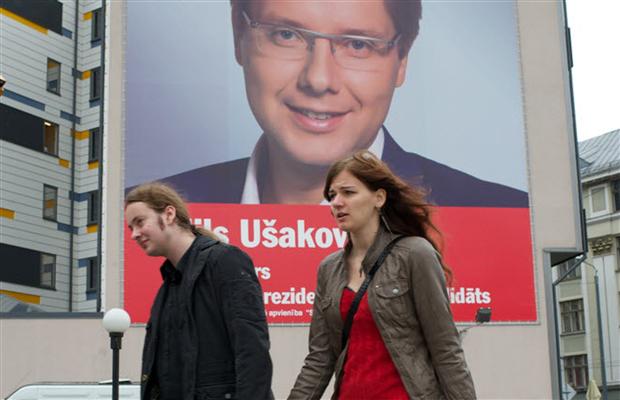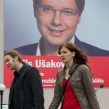
After Elections, Latvia Can Have a Latvian Government Again (Part One)
Publication: Eurasia Daily Monitor Volume: 8 Issue: 175
By:

As anticipated (see EDM, July 27, 28), Latvia’s parliamentary elections held on September 17 have brought the country to a potentially fateful crossroads. The choice is between consolidating Latvia’s national statehood as part of the West, or empowering the leftist Russian party to undermine those Latvian goals from within a new coalition government. The Russian party, Harmony Center, officially linked with the Kremlin’s United Russia party in a partnership agreement, opposes those Latvian policies that have secured the country’s place within NATO and the EU, and seeks to change them.
For the first time since the restoration of Latvia’s independence 20 years ago, the issue of bringing the Russian party into a coalition government is now on the agenda. It is an unnecessary issue, not warranted by Latvia’s parliamentary arithmetic, but pushed by Moscow, with a confused nod from some residual supporters of European multiculturalism, after this model’s collapse (albeit under different circumstances) in Western Europe itself. In the newly elected Latvian parliament, however, three Western-oriented parties hold enough seats to ensure successful governance, in a negotiable coalition formula.
The Russian party has registered its best-ever score in the September 17 elections, gaining first place, albeit with just 28 percent of the total votes cast. The party attracts few Latvian voters. Despite its Harmony label, the party thrives not by bridging societal divisions, but, on the contrary, thanks to monolithic Russian/”Russian-speaking” voting, contrasting with the dispersal of Latvian votes among several Latvian parties.
In the newly elected parliament of 100 seats, Harmony holds 31 seats; the center-right Zatlers’s Reform Party, just created by former president (2007-2011) Valdis Zatlers, 22 seats; the right-leaning Unity Party, 20 seats; the nationalist (though left-leaning on some social issues) National Alliance-All for Latvia, 14 seats; and the oligarch-controlled Greens and Farmers’ Union, 13 seats (BNS, September 19, 20).
Zatlers’s Reform Party, the Unity Party, and All for Latvia, are natural allies in their Western orientation, commitment to market economics, and anti-corruption efforts as a matter of state consolidation for Latvia. With their total of 56 seats in parliament, these three parties can form together a stable majority. This can take the form of a three-party government, or a government of the Zatlers and Unity parties supported by All for Latvia in parliament. These three parties’ alignment had already emerged prior to the elections, as All for Latvia was supporting Unity and then-president Zatlers in parliament.
The three Western-oriented parties rule out any coalition with “oligarchic” interests and politicians representing such interests. The Greens and Farmers (political home of the recently elected head of state, Andris Berzins) are the last party of this type surviving in parliament after these elections, at half of its former strength. The three Western-oriented parties have drawn a “red line” against any coalescence with it.
However, Zatlers’s Reform Party has entered into post-election consultations with Harmony Center, half-opening the prospect of negotiating Harmony’s participation in a new coalition government. The Unity Party (or, at least, a critical mass within it) harbors deep misgivings about this; and All for Latvia would almost certainly oppose Harmony’s participation in government. A coalition deal with Harmony would risk dividing Latvian parties, internally as well as from each other. Since the parliamentary arithmetic does not require a coalition with Harmony, the consultations about this possibility look even more confusing.
The incumbent government under Prime Minister Valdis Dombrovskis and Finance Minister Andris Vilks (both from Unity) is successfully leading Latvia’s recovery from a deep economic crisis. The government imposed drastic austerity measures to pave the way for recovery, with first positive results showing before the elections. The European Union, the International Monetary Fund, and credit rating agencies are citing Latvia as a rare success in Europe in this regard (BNS, Delfi, LETA, September 16-21; Latvia in Review, September 5-12, 13-20).
The signals from those institutions suggest support for this economic team to remain in government. Harmony Center, however, campaigned against the government’s austerity measures and its European orientation generally. The Latvian parties’ electorate generally accepted the austerity measures, whereas Harmony capitalized on its Russian electorate opposing them. Harmony’s hypothetical entry into the government would jeopardize the recovery and thin out the economic reformers’ political base.
Harmony’s parliamentary leader, Janis Urbanovics (theoretically though unrealistically a prime-ministerial candidate), as well as Russian government-inspired editorials in Moscow, suggest that only “neo-fascists” or “semi-fascists” would reject Harmony’s participation in Latvia’s government (Rossiyskaya Gazeta, September 20; Neatkariga Rita Avize, September 21).
Harmony Center and Moscow policy planners have apparently set the goal of joining a governing coalition as their maximum goal, and destabilizing a possible Latvian coalition through wedge-drawing tactics as their minimum goal in the negotiations. They seek to de-legitimize some Latvian political forces as “nationalist,” even as Harmony itself capitalizes on its Moscow ties. While warning that a government without Harmony’s participation would be short-lived and necessitate new elections, Harmony works closely with residual oligarch groups that oppose the government and are enmeshed with Russian business interests.




